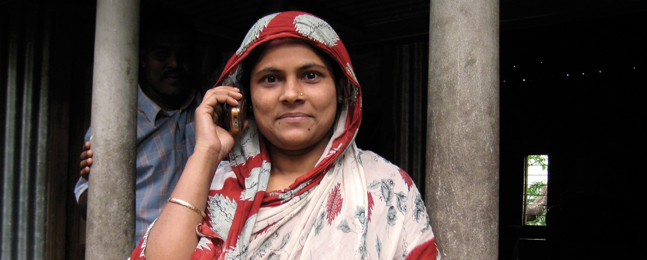The Hidden Ways Microfinance Hurts Women

Lamia Karim
by Lamia Karim ’84
Grameen Bank, which won the Nobel Peace Prize in 2006, earned its celebrated reputation by helping poor women in Bangladesh become entrepreneurs. Through microfinance loans — small amounts of capital that fund the start of modest businesses — Grameen demonstrated that the poor are “bankable,” and boasted an impressive 98 percent loan recovery rate.
Today, microfinance is a global multi-billion dollar industry with operations on all continents. As a result, over the past three decades microfinance has become inextricably linked to women’s empowerment in developing countries. Yet in research I conducted in Bangladesh in 1998-99 and 2007, I discovered a soft, ugly underbelly to microfinance, particularly as it affects poor women.
If you replace the word “loan” with “debt,” it’s easy to see how microfinance can create a power imbalance between a lender and a financially strapped borrower, especially if that borrower is a woman. A central problem is this: In the world of microfinance, women borrowers are viewed as autonomous individuals who make independent choices in the marketplace.
But this is not the reality. Even when they possess marketable, loan-worthy skills, women often find themselves beholden to their husband and male relatives. Rural Bangladeshi women live in extended family structures. They negotiate complex kinship and social obligations.
It’s not surprising to learn, therefore, that in almost 90 percent of cases men control the loans that women receive, often with adverse effects. The men may simply use the money for their own purposes. They may force women to take out loans from multiple institutions, leading to an accumulation of debt the women are unable to repay. A groom may demand that his bride’s family pay a larger-than-normal dowry, one based not just on family income and assets but on the bride’s capacity to bring in loans.
In addition to male control, other problems affect a woman’s ability to repay a loan. Lenders may extend loans to prospective dairy-cow breeders or egg sellers without doing any market survey of how many dairy-cow breeders or egg sellers the economy of a particular area can sustain. Micro-entrepreneurs may be undone by an unexpected illness, a poor investment decision or a theft.
page 2 of 2
A Bangladeshi woman’s conduct is strictly controlled: She is the custodian of family honor. When defaults occur — and they happen routinely for a variety of reasons — troubles rain down on her.
In a ripple effect, women who cannot repay a loan are subjected to public shaming by the entire community of borrowers, who are pressured hard by microfinance institutions to recover or repay the defaulted sum themselves, lest they risk losing access to future loans. A defaulting woman therefore faces the ire of other borrowers who see her as breaking faith with them, and, instead of developing social solidarity, the loans heighten social tension. Add to this the fact that shamed women are seen as bringing dishonor on their husband and family, and you get a sense of the tensions women borrowers face.
Microfinance loans have also made petty moneylenders out of female borrowers. Instead of starting micro-businesses, rural women can stay at home — the expected social custom — and lend money to traders, farmers and others in the community. As these loans circulate out to a wider group of people, the complicated web of dependent relationships becomes even further entangled.
There are, of course, women who use their microfinance loans productively. For the most part, these are women who have marketable skills or already own their own small businesses. They also tend to be women who are widowed, abandoned or divorced — who have no husband to lay claim to their income. Within the vast pool of borrowers, however, such women make up a small minority.
Even in the area of social business — a concept devised by Muhammad Yunus, founder of Grameen Bank — women can be victimized by powerful interests. In 1997, Grameen and Telenor Norway, one of the world’s major mobile-telecommunications operators, jointly created a venture called Grameen Polli Phone (or “Village Phone”), which offered rural Bangladeshis easy access to phone services.
As part of its business plan, Grameen gave would-be entrepreneurs known as “phone ladies” loans to buy a cell phone. The phone ladies could then sell time on the phone to neighbors who needed to make a call. The phone and its paraphernalia and fees — antenna, charger, battery, security deposit, connection fee — cost approximately $700 in the early 2000s.
Initially, many of the Grameen phone ladies made money. But soon other cell phone companies moved into their areas and effortlessly undersold them. With their customers gone, many of these women were still stuck with huge debts to repay.
The phone ladies had little or no understanding of how competition works in an open market. But Grameen Polli Phone did. At the end of the day, the corporation used these women to usher in new corporate market forces and corner new markets. And the women were left as poor — or poorer — than they were before they got their loan.
Lamia Karim ’84 came to Brandeis as a Wien Scholar. She is an associate professor of anthropology at the University of Oregon and the author of “Microfinance and Its Discontents: Women in Debt in Bangladesh” (University of Minnesota Press, 2011).
